2.2E: Exercises for Section 2.2
- Page ID
- 93356
\( \newcommand{\vecs}[1]{\overset { \scriptstyle \rightharpoonup} {\mathbf{#1}} } \)
\( \newcommand{\vecd}[1]{\overset{-\!-\!\rightharpoonup}{\vphantom{a}\smash {#1}}} \)
\( \newcommand{\id}{\mathrm{id}}\) \( \newcommand{\Span}{\mathrm{span}}\)
( \newcommand{\kernel}{\mathrm{null}\,}\) \( \newcommand{\range}{\mathrm{range}\,}\)
\( \newcommand{\RealPart}{\mathrm{Re}}\) \( \newcommand{\ImaginaryPart}{\mathrm{Im}}\)
\( \newcommand{\Argument}{\mathrm{Arg}}\) \( \newcommand{\norm}[1]{\| #1 \|}\)
\( \newcommand{\inner}[2]{\langle #1, #2 \rangle}\)
\( \newcommand{\Span}{\mathrm{span}}\)
\( \newcommand{\id}{\mathrm{id}}\)
\( \newcommand{\Span}{\mathrm{span}}\)
\( \newcommand{\kernel}{\mathrm{null}\,}\)
\( \newcommand{\range}{\mathrm{range}\,}\)
\( \newcommand{\RealPart}{\mathrm{Re}}\)
\( \newcommand{\ImaginaryPart}{\mathrm{Im}}\)
\( \newcommand{\Argument}{\mathrm{Arg}}\)
\( \newcommand{\norm}[1]{\| #1 \|}\)
\( \newcommand{\inner}[2]{\langle #1, #2 \rangle}\)
\( \newcommand{\Span}{\mathrm{span}}\) \( \newcommand{\AA}{\unicode[.8,0]{x212B}}\)
\( \newcommand{\vectorA}[1]{\vec{#1}} % arrow\)
\( \newcommand{\vectorAt}[1]{\vec{\text{#1}}} % arrow\)
\( \newcommand{\vectorB}[1]{\overset { \scriptstyle \rightharpoonup} {\mathbf{#1}} } \)
\( \newcommand{\vectorC}[1]{\textbf{#1}} \)
\( \newcommand{\vectorD}[1]{\overrightarrow{#1}} \)
\( \newcommand{\vectorDt}[1]{\overrightarrow{\text{#1}}} \)
\( \newcommand{\vectE}[1]{\overset{-\!-\!\rightharpoonup}{\vphantom{a}\smash{\mathbf {#1}}}} \)
\( \newcommand{\vecs}[1]{\overset { \scriptstyle \rightharpoonup} {\mathbf{#1}} } \)
\( \newcommand{\vecd}[1]{\overset{-\!-\!\rightharpoonup}{\vphantom{a}\smash {#1}}} \)
Intuitive Definition of Limits
For exercises 1 - 2, consider the function \(f(x)=\dfrac{x^2−1}{|x−1|}\).
1) [T] Complete the following table for the function. Round your solutions to four decimal places.
| \(x\) | \(f(x)\) | \(x\) | \(f(x)\) |
|---|---|---|---|
| 0.9 | a. | 1.1 | e. |
| 0.99 | b. | 1.01 | f. |
| 0.999 | c. | 1.001 | g. |
| 0.9999 | d. | 1.0001 | h. |
2) What do your results in the preceding exercise indicate about the two-sided limit \(\displaystyle \lim_{x→1}f(x)\)? Explain your response.
- Answer
-
\(\displaystyle \lim_{x \to 1}f(x)\) does not exist because \(\displaystyle \lim_{x \to 1^−}f(x)=−2≠\lim_{x \to 1^+}f(x)=2\).
For exercises 3 - 5, consider the function \(f(x)=(1+x)^{1/x}\).
3) [T] Make a table showing the values of \(f\) for \(x=−0.01,\;−0.001,\;−0.0001,\;−0.00001\) and for \(x=0.01,\;0.001,\;0.0001,\;0.00001\). Round your solutions to five decimal places.
| \(x\) | \(f(x)\) | \(x\) | \(f(x)\) |
|---|---|---|---|
| -0.01 | a. | 0.01 | e. |
| -0.001 | b. | 0.001 | f. |
| -0.0001 | c. | 0.0001 | g. |
| -0.00001 | d. | 0.00001 | h. |
4) What does the table of values in the preceding exercise indicate about the function \(f(x)=(1+x)^{1/x}\)?
- Answer
- \(\displaystyle \lim_{x \to 0}(1+x)^{1/x}\approx 2.7183\).
5) To which mathematical constant do the values in the preceding exercise appear to be approaching? This is the actual limit here.
In exercises 6 - 8, use the given values to set up a table to evaluate the limits. Round your solutions to eight decimal places.
6) [T] \(\displaystyle \lim_{x \to 0}\frac{\sin 2x}{x};\quad ±0.1,\; ±0.01, \; ±0.001, \;±.0001\)
| \(x\) | \(\frac{\sin 2x}{x}\) | \(x\) | \(\frac{\sin 2x}{x}\) |
|---|---|---|---|
| -0.1 | a. | 0.1 | e. |
| -0.01 | b. | 0.01 | f. |
| -0.001 | c. | 0.001 | g. |
| -0.0001 | d. | 0.0001 | h. |
- Answer
- a. 1.98669331; b. 1.99986667; c. 1.99999867; d. 1.99999999; e. 1.98669331; f. 1.99986667; g. 1.99999867; h. 1.99999999;
\(\displaystyle \lim_{x \to 0}\frac{\sin 2x}{x}=2\)
7) [T] \(\displaystyle \lim_{x \to 0}\frac{\sin 3x}{x} ±0.1, \; ±0.01, \; ±0.001, \; ±0.0001\)
| \(x\) | \(\frac{\sin 3x}{x}\) | \(x\) | \(\frac{\sin 3x}{x}\) |
|---|---|---|---|
| -0.1 | a. | 0.1 | e. |
| -0.01 | b. | 0.01 | f. |
| -0.001 | c. | 0.001 | g. |
| -0.0001 | d. | 0.0001 | h. |
8) Use the preceding two exercises to conjecture (guess) the value of the following limit: \(\displaystyle \lim_{x \to 0}\frac{\sin ax}{x}\) for \(a\), a positive real value.
- Answer
- \(\displaystyle \lim_{x \to 0}\frac{\sin ax}{x}=a\)
[T] In exercises 9 - 12, set up a table of values to find the indicated limit. Round to eight significant digits.
9) \(\displaystyle \lim_{x \to 1}(1−2x)\)
| \(x\) | \(1−2x\) | \(x\) | \(1−2x\) |
|---|---|---|---|
| 0.9 | a. | 1.1 | e. |
| 0.99 | b. | 1.01 | f. |
| 0.999 | c. | 1.001 | g. |
| 0.9999 | d. | 1.0001 | h. |
- Answer
- a. −0.80000000; b. −0.98000000; c. −0.99800000; d. −0.99980000; e. −1.2000000; f. −1.0200000; g. −1.0020000; h. −1.0002000;
\( \displaystyle \lim_{x \to 1}(1−2x)=−1\)
10) \(\displaystyle \lim_{x \to 0}\frac{5}{1−e^{1/x}}\)
| \(x\) | \(\frac{5}{1−e^{1/x}}\) | \(x\) | \(\frac{5}{1−e^{1/x}}\) |
|---|---|---|---|
| -0.1 | a. | 0.1 | e. |
| -0.01 | b. | 0.01 | f. |
| -0.001 | c. | 0.001 | g. |
| -0.0001 | d. | 0.0001 | h. |
11) \(\displaystyle \lim_{t \to 0^+}\frac{\cos t}{t}\)
| \(t\) | \(\frac{\cos t}{t}\) |
|---|---|
| 0.1 | a. |
| 0.01 | b. |
| 0.001 | c. |
| 0.0001 | d. |
12) \(\displaystyle \lim_{x \to 2}\frac{1−\frac{2}{x}}{x^2−4}\)
| \(x\) | \(\frac{1−\frac{2}{x}}{x^2−4}\) | \(x\) | \(\frac{1−\frac{2}{x}}{x^2−4}\) |
|---|---|---|---|
| 1.9 | a. | 2.1 | e. |
| 1.99 | b. | 2.01 | f. |
| 1.999 | c. | 2.001 | g. |
| 1.9999 | d. | 2.0001 | h. |
- Answer
- a. 0.13495277; b. 0.12594300; c. 0.12509381; d. 0.12500938; e. 0.11614402; f. 0.12406794; g. 0.12490631; h. 0.12499063;
\( \displaystyle ∴\lim_{x \to 2}\frac{1−\frac{2}{x}}{x^2−4}=0.1250=\frac{1}{8}\)
[T] In exercise 13, set up a table of values and round to eight significant digits. Based on the table of values, make a guess about what the limit is. Then, use a calculator to graph the function and determine the limit. Was the conjecture correct? If not, why does the method of tables fail?
13) \(\displaystyle \lim_{θ \to 0}\sin\left(\frac{π}{θ}\right)\)
| \(θ\) | \(\sin\left(\frac{π}{θ}\right)\) | \(θ\) | \(\sin\left(\frac{π}{θ}\right)\) |
|---|---|---|---|
| -0.1 | a. | 0.1 | e. |
| -0.01 | b. | 0.01 | f. |
| -0.001 | c. | 0.001 | g. |
| -0.0001 | d. | 0.0001 | h. |
In exercises 14 - 18, use the following graph of the function \(y=f(x)\) to find the values, if possible. Estimate when necessary.
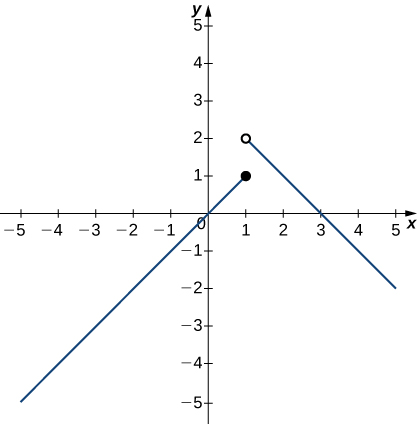
14) \(\displaystyle \lim_{x→1^−}f(x)\)
15) \(\displaystyle \lim_{x→1^+}f(x)\)
- Answer
- \(2\)
16) \(\displaystyle \lim_{x→1}f(x)\)
17) \(\displaystyle \lim_{x→2}f(x)\)
- Answer
- \(1\)
18) \(f(1)\)
In exercises 19 - 22, use the graph of the function \(y=f(x)\) shown here to find the values, if possible. Estimate when necessary.
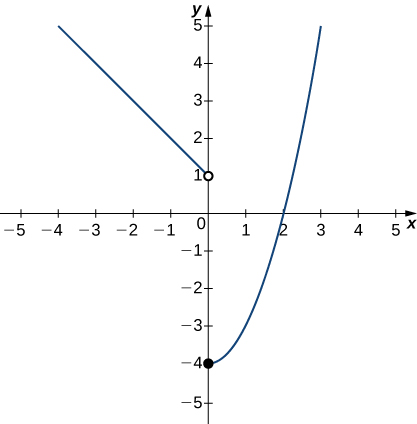
19) \(\displaystyle \lim_{x→0^−}f(x)\)
- Answer
- \(1\)
20) \(\displaystyle \lim_{x→0^+}f(x)\)
21) \(\displaystyle \lim_{x→0}f(x)\)
- Answer
- DNE
22) \(\displaystyle \lim_{x→2}f(x)\)
In exercises 23 - 35, use the graph of the function \(y=f(x)\) shown here to find the values, if possible. Estimate when necessary.
![A graph of a piecewise function with three segments, all linear. The first exists for x < -2, has a slope of 1, and ends at the open circle at (-2, 0). The second exists over the interval [-2, 2], has a slope of -1, goes through the origin, and has closed circles at its endpoints (-2, 2) and (2,-2). The third exists for x>2, has a slope of 1, and begins at the open circle (2,2).](https://math.libretexts.org/@api/deki/files/1897/CNX_Calc_Figure_02_02_204.jpeg?revision=1&size=bestfit&width=417&height=424)
23) \(\displaystyle \lim_{x→−2^−}f(x)\)
- Answer
- \(0\)
24) \(\displaystyle \lim_{x→−2^+}f(x)\)
25) \(\displaystyle \lim_{x→−2}f(x)\)
- Answer
- DNE
26) \(\displaystyle \lim_{x→2^−}f(x)\)
27) \(\displaystyle \lim_{x→2^+}f(x)\)
- Answer
- \(2\)
28) \(\displaystyle \lim_{x→2}f(x)\)
In exercises 29 - 31, use the graph of the function \(y=g(x)\) shown here to find the values, if possible. Estimate when necessary.
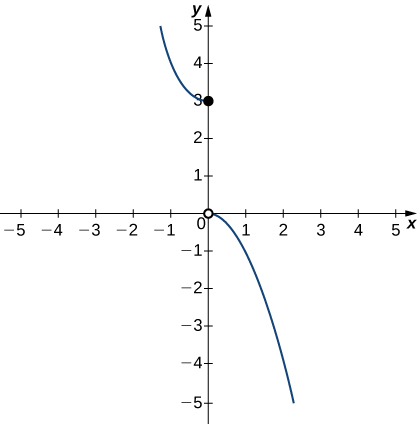
29) \(\displaystyle \lim_{x→0^−}g(x)\)
- Answer
- \(3\)
30) \(\displaystyle \lim_{x→0^+}g(x)\)
31) \(\displaystyle \lim_{x→0}g(x)\)
- Answer
- DNE
In exercises 32 - 34, use the graph of the function \(y=h(x)\) shown here to find the values, if possible. Estimate when necessary.
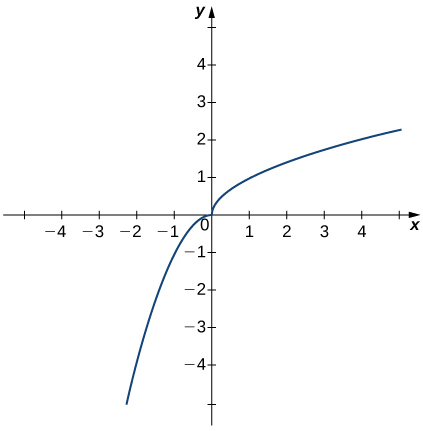
32) \(\displaystyle \lim_{x→0^−}h(x)\)
33) \(\displaystyle \lim_{x→0^+}h(x)\)
- Answer
- \(0\)
34) \(\displaystyle \lim_{x→0}h(x)\)
In exercises 35 - 39, use the graph of the function \(y=f(x)\) shown here to find the values, if possible. Estimate when necessary.
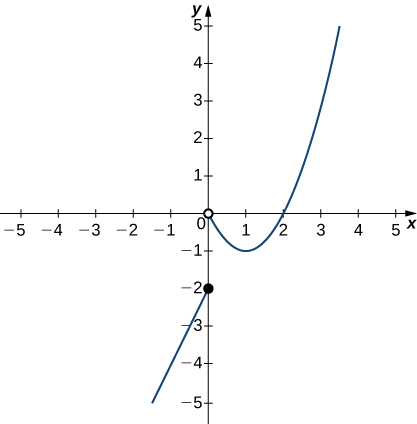
35) \(\displaystyle \lim_{x→0^−}f(x)\)
- Answer
- \(-2\)
36) \(\displaystyle \lim_{x→0^+}f(x)\)
37) \(\displaystyle \lim_{x→0}f(x)\)
- Answer
- DNE
38) \(\displaystyle \lim_{x→1}f(x)\)
39) \(\displaystyle \lim_{x→2}f(x)\)
- Answer
- \(0\)
40) A track coach uses a camera with a fast shutter to estimate the position of a runner with respect to time. A table of the values of position of the athlete versus time is given here, where \(x\) is the position in meters of the runner and \(t\) is time in seconds. What is \(\displaystyle \lim_{t→2}x(t)\)? What does it mean physically?
| \(t(sec)\) | \(x(m)\) |
|---|---|
| 1.75 | 4.5 |
| 1.95 | 6.1 |
| 1.99 | 6.42 |
| 2.01 | 6.58 |
| 2.05 | 6.9 |
| 2.25 | 8.5 |
Contributors and Attributions
Gilbert Strang (MIT) and Edwin “Jed” Herman (Harvey Mudd) with many contributing authors. This content by OpenStax is licensed with a CC-BY-SA-NC 4.0 license. Download for free at http://cnx.org.


